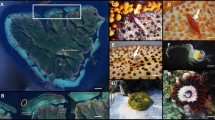Abstract
Chemical communications play an important role in plants, fungi, and algae. Volatile organic compounds in marine algae are released into the seawater. These compounds play a role as either pheromones or allelochemicals. We observed that the turbinid gastropod Lunella coronata coreensis inhabits the intertidal zone and often grazes the green alga Ulva pertusa. Feeding tests and feeding preference studies were performed with green, brown and red algae or by using the powdered freeze-dried seaweed in agar. The snails fed on U. pertusa preferentially compared to the other marine algae, and recognized chemoreception compounds from the alga but not their structural or morphological differences. From feeding tests using artificial foods, it is suggested that the feeding attractants are in the essential oil of the alga U. pertusa.




Similar content being viewed by others
References
Akakabe Y, Matsui K, Kajiwara T (1999) Enantioselective α-hydroperoxylation of long-chain fatty acids with crude enzyme of marine green alga Ulva pertusa. Tet Lett 40:1137–1140
Akakabe Y, Matsui K, Kajiwara T (2000) α-Oxidation of long-chain unsaturated fatty acids in the marine green alga Ulva pertusa. Biosci Biotechnol Biochem 64:2680–2681
Akakabe Y, Matsui K, Kajiwara T (2001) Enantioselective 2-hydroperoxylation of long-chain fatty acids in marine green algae. Fisheries Sci 67:328–332
Akakabe Y, Matsui K, Kajiwara T (2003) 2,4-Decadienals are produced via (R)-11-HPITE from arachidonic acid in marine green alga Ulva conglobata. Bioorg Med Chem 11:3607–3609
Bakus GJ, Targett NM, Schulte B (1986) Chemical ecology of marine organisms: an overview. J Chem Ecol 12:951–987
Boonprab K, Matsui K, Akakabe Y, Yotsukura N, Kajiwara T (2003) Hydroperoxy-arachidonic acid mediated n-hexanal and (Z)-3- and (E)-2-nonenals formation in Laminaria angustata. Phytochem 63:669–678
Boonprab K, Matsui K, Akakabe Y, Yoshida M, Yotsukura N, Chirapart A, Kajiwara T (2006) Formation of aldehyde flavor (n-hexanal, 3Z-nonenal and 2E-nonenal) in the brown alga, Laminaria angustata. J Appl Phycol 18:1573–1576
Davis AR, Targett NM, McConnell OJ, Young CM (1989) Epibiosis of marine algae and benthic invertebrates: natural products chemistry and other mechanisms inhibiting settlement and overgrowth. In: Scheuer PJ (ed), Bioorganic Marine Chemistry, vol 3. Springer, Berlin, pp 85–114
Hay ME, Piel J, Boland W, Schnitzler I (1998) Seaweed sex pheromones and their degradation products frequently suppress amphipod feeding but rarely suppress sea urchin feeding. Chemoecology 8:91–98
Kajiwara T, Yamamoto Y, Akakabe Y, Matsui K, Shimizu H, Kawai T (2003) Biomimetic conversion of (3S)-(−)-neodictyoprolenol to optically pure (1S,2R)-(−)-dictyopterene B, marine algal sex pheromone. Z Naturf 58c:109–112
Melton T, Bodnar JW (1988) Molecular biology of marine microorganisms: biotechnological approaches to naval problems. Nat Res Rev 40:24–39
Pelletreau K, Muller-Parker G (2002) Sulfuric acid in the phaeophyte alga Desmarestia munda deters feeding by the sea urchin Strongylocentrotus droebachiensis. Mar Biol 141:1–9
Pohnert G (2002) Phospholipase A2 activity triggers the wound-activated chemical defense in the diatom Thalassiosira rotula. Plant Physiol 129:103–111
Pohnert G, Boland W (2002) The oxylipin chemistry of attraction and defense in brown algae and diatoms. Nat Prod Rep 19:108–122
Sakata KN, Sakura T, Ina K (1988) Algal phagostimulants for marine herbivorous gastropods. J Chem Ecol 14:1405–1416
Schnitzler I, Pohnert G, Hay ME, Boland W (2001) Chemical defense of brown algae (Dictyopteris spp.) against the herbivorous amphipod Ampithoe longimana. Oecologia 126:515–521
Suzuki Y, Takabayashi T, Kawaguchi T, Matsunaga K (1998) Isolation of an allelopathic substance from the crustose coralline algae, Lithophyllum spp., and its effect on the brown alga, Laminaria religiosa Miyabe (Phaeophyta). J Exp Mar Biol Ecol 225:69–77
Van Alstyne KL, Houser LT (2003) Dimethylsulfide release during macroinvertebrate grazing and its role as an activated chemical defense. Mar Ecol Prog Ser 250:175–181
Yamamoto Y, Akakabe Y, Matsui K, Shimizu H, Kajiwara T (2000) Neodictyoprolenol and dictyoprolenol, the possible biosynthetic intermediates of dictyopterenes, in the Japanese brown algae Dictyopteris. Z Naturf 56c:6–12
Author information
Authors and Affiliations
Corresponding author
Rights and permissions
About this article
Cite this article
Akakabe, Y., Kajiwara, T. Bioactive volatile compounds from marine algae: feeding attractants. J Appl Phycol 20, 661–664 (2008). https://doi.org/10.1007/s10811-007-9309-x
Received:
Revised:
Accepted:
Published:
Issue Date:
DOI: https://doi.org/10.1007/s10811-007-9309-x




